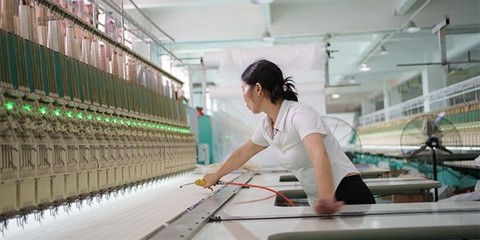
A worker at work. Việt Nam emerges as a prominent hub as companies diversify manufacturing capabilities to complement existing bases outside China. — Photo Courtesy of JLL Vietnam
Southeast Asia and India stand to be net beneficiaries of companies diversifying manufacturing capabilities to complement existing bases in China, according to a new report by Jones Lang Lasalle (JLL), a global commercial real estate and investment management company.
The company stressed that “companies will need to be flexible when considering locations and funding options to take advantage of volatility in supply chains.”
JLL said that the next decade will accelerate shifting supply chains whereby manufacturing and production locations will diversify to multiple locations across Southeast Asia and India.
In recent years, companies have begun exploring the relocation of manufacturing operations beyond China, adopting strategies such as the China+1 approach to mitigate supply chain risks and reduce dependence on a single country.
Michael Ignatiadis, head of manufacturing strategy, Asia Pacific at JLL, emphasised the importance of diversifying supply chains within the region's economic lifecycle. He noted that Southeast Asia and India present ideal complements to China's existing production capabilities, underscoring the need for companies to maintain agility in land selection and financing to adapt swiftly to supply chain transformations.
“Diversification within supply chains is a natural step for companies involved in manufacturing within the wider economic lifecycle of this region. We see Southeast Asia and India representing a natural complement to the existing production strength of China but feel that for companies to respond quickly to supply chain shifts, they need to adopt a flexible mindset towards land selection and funding options,” he said.
The shift towards diversification is fueled not only by the imperative of supply chain resilience but also by attractive economic fundamentals in these regions, including sizable populations, abundant labor resources, cost efficiencies, and various incentives. These factors position Southeast Asia and India as key manufacturing hubs for global markets.
Việt Nam – a growing hub
Việt Nam has emerged as a prominent hub within this evolving landscape.
JLL highlighted the country's growing significance and described it as a hub with strengths extending beyond electronics manufacturing.
Trang Lê, head of research and consulting for Việt Nam, and senior director of manufacturing strategy research for Asia Pacific at JLL, emphasised Việt Nam's appeal as a destination for manufacturing investments.
“In the face of the potential reshaping of global trade by the global diversification of supply chains in the manufacturing and processing industry, Việt Nam is emerging as a growing hub. Việt Nam's reputation as an electronics manufacturing hub is well-deserved, but its capabilities extend far beyond,” said Trang.
As an export-oriented economy, Việt Nam's Government is actively fostering business growth, offering a range of investment incentives to attract foreign capital, such as tax breaks, import duty exemptions or reductions, land and rent incentives, and comprehensive operational support throughout the investment journey.
The country has also ratified and implemented numerous free trade agreements, streamlining trade processes, reducing barriers, and offering favourable terms for manufacturing ventures.
Aligned with its national vision for 2021-2030 and towards 2050, Việt Nam aims to evolve into an upper middle-income country with a modern industrial base, emphasising science, technology, innovation, and digitalisation.
The country's State Administration Reform Programme for 2021-2030 is geared towards simplifying administrative procedures, fostering business development in the digital era, and enhancing efficiencies for businesses and investors through procedural simplification.
Moreover, Việt Nam's commitment to Public-Private Partnerships since 2020 aims to catalyse private investment in critical infrastructure projects, thereby improving transportation networks, power grids, industrial zones, and boosting logistics, connectivity, and operational efficiency.
Last but not least, Việt Nam pledged to phase out coal power generation by the 2040s and achieve net-zero carbon emissions by 2050. This commitment positions the country as an attractive destination for manufacturers seeking sustainable production environments.
JLL's report also identifies diverse opportunities for investors in Việt Nam across sectors such as computer and electronics, chemicals, fabricated metal products, rubber and plastic goods, apparel and textiles, and food processing. — VNS